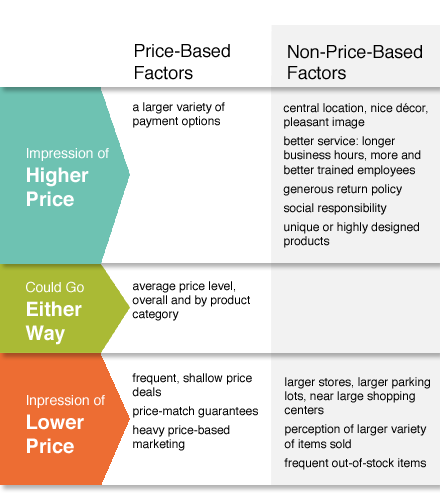Price-conscious shoppers are a popular target for marketers, but there’s a lot beyond deals and coupons that influence consumer perception of a business’s pricing. Using these more subtle factors can be a valuable tool for crafting effective marketing copy.
Consider this: you are planning a party, but now isn’t the best time to be spending lots of money on entertaining. Where are you more likely to go for party supplies like hummus and pita chips: your local supermarket or Whole Foods? While individual product pricing certainly influences a consumer’s likelihood of making a purchase, the overall impression of a retailer’s pricing has a large impact on consumers’ shopping and purchasing patterns. With a nickname “Whole Paycheck”, Whole Foods might not be the first choice of budget-conscious shoppers. The reality is that Whole Foods is often competitive when it comes to individual product pricing, but the impression remains that they are very expensive.
Price image is comprised of a variety of factors, many unrelated to actual prices. In a research paper compiling the results of over 40 previous studies, Ryan Hamilton, of Emory University’s Goizueta Business School, and Alexander Chernev of Northwestern’s Kellogg School of Management outline price-based and non-priced based contributors to a retailer’s price image. An impression of lower price is driven by the thought that larger inventory/selection/physical space/sales volume gives retailers the buying power to offer low prices, whereas an impression of higher price is generated from factors which imply more store costs are included in the purchase price. In some cases, factors that influence perception are quite indirect, such as better trained employees (perceived as more expensive) and larger parking lots (perceived as less expensive). The following table outlines the paper’s findings.
Implications for Digital Advertising
As advertisers, we can’t expect to change the price image of a store based on a few ads, but we can influence the price perception of the business we are advertising, or start to construct a price image for an unfamiliar brand. Following are a few principles we have employed at Two Octobers.
Don’t send an inappropriate pricing cue
Ads should take care to reinforce the price image conveyed by the business’ website. For example, it would be inappropriate and ultimately ineffective to include the price of a sofa in an ad for a furniture company with a luxury price image. We tend to think of price as a primary consideration when crafting an ad, but it can become a negative factor when a business is not the lowest price provider.
Craft ad copy that promotes the virtues of the businesses’ price image
- For high-priced products, use language that supports a higher price image, such as service level, social responsibility, generous return policy, etc. This will help ensure that the right audience is seeing and responding to your ad.
- When it isn’t feasible to include the actual price in the ad, reinforce low price image by emphasizing selection, large customer base, sales volume, etc.
- When competitors are advertising prices, test ads with pricing against ads with low-price cues. Each approach may appeal to different buyers or different products.





